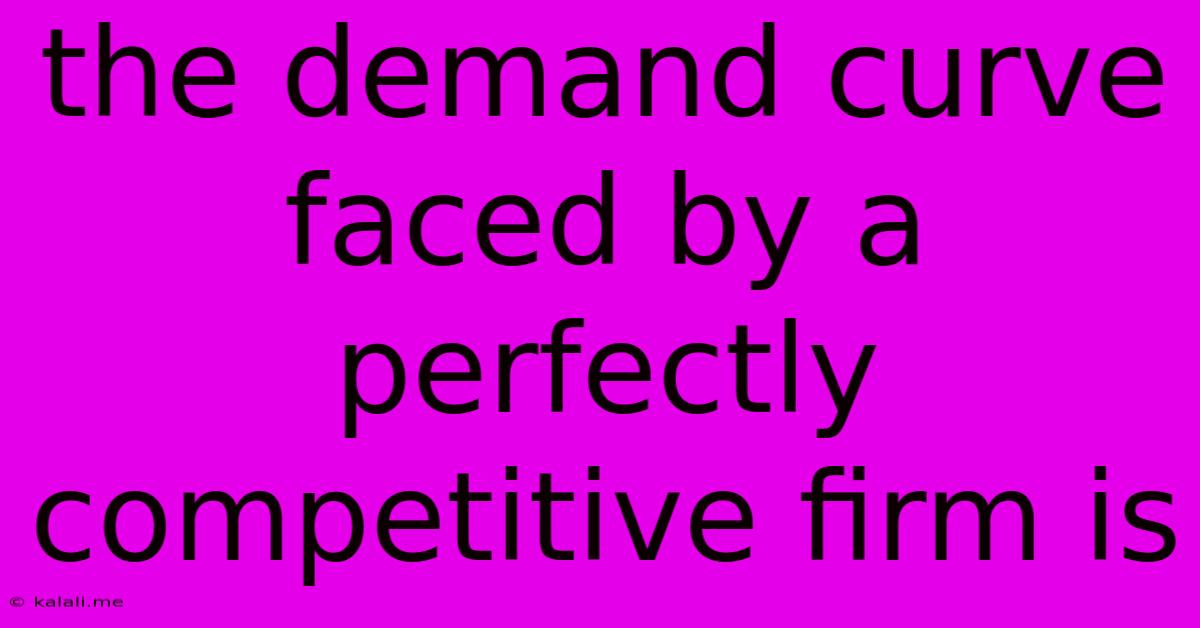The Demand Curve Faced By A Perfectly Competitive Firm Is
Kalali
Jun 15, 2025 · 3 min read

Table of Contents
The Demand Curve Faced by a Perfectly Competitive Firm: A Flat Line of Truth
The demand curve faced by a perfectly competitive firm is a critical concept in microeconomics. Understanding its unique characteristics is essential for grasping how these firms operate and make decisions regarding pricing and output. This article will delve into the specifics of this demand curve, explaining why it's perfectly elastic and what implications this has for the firm's market power.
What is a Perfectly Competitive Market?
Before diving into the demand curve, it's crucial to define a perfectly competitive market. These markets are characterized by several key features:
- Many buyers and sellers: No single buyer or seller can influence the market price.
- Homogenous products: Products offered by different firms are identical or nearly identical. Consumers see no difference between the products of one firm and another.
- Free entry and exit: Firms can easily enter or leave the market without significant barriers.
- Perfect information: All buyers and sellers have complete information about prices and product quality.
These conditions rarely exist perfectly in the real world. However, some markets, like agricultural commodities (e.g., wheat, corn) come close to approximating perfect competition.
The Perfectly Elastic Demand Curve: A Horizontal Line
The defining characteristic of the demand curve faced by a perfectly competitive firm is its perfect elasticity. This means the demand curve is a perfectly horizontal line. This seemingly counter-intuitive concept stems directly from the characteristics of perfect competition outlined above.
-
Price Takers: Because there are many firms selling identical products, each firm is a price taker. They have no control over the market price. They can sell as much as they want at the prevailing market price, but they cannot charge a higher price. If they attempt to raise their price, even slightly, consumers will simply switch to another firm offering the same product at the lower market price.
-
Infinitely Elastic Demand: The firm faces infinitely elastic demand at the market price. This means that if the firm tries to charge even a penny more than the market price, the quantity demanded of its product will fall to zero. Conversely, they can sell as much as they want at the market price without impacting the price itself.
Implications for Firm Behavior
The perfectly elastic demand curve has significant implications for how perfectly competitive firms operate:
-
Focus on Output: Since firms cannot influence price, their primary focus is on optimizing their output to maximize profits. This involves finding the production level where marginal cost equals the market price (MC = P).
-
No Market Power: Perfectly competitive firms lack any market power. They are price takers, meaning they have no ability to set prices independently. This contrasts sharply with firms operating in monopolistic or oligopolistic markets, which have greater pricing power.
-
Short-Run and Long-Run Adjustments: In the short run, firms may experience economic profits or losses. However, in the long run, due to free entry and exit, economic profits will be driven to zero. This is because if firms are making profits, new firms will enter the market, increasing supply and lowering prices. If firms are experiencing losses, some firms will exit, reducing supply and raising prices.
In Conclusion
The perfectly elastic demand curve faced by a perfectly competitive firm is a fundamental concept illustrating the power of market forces in a perfectly competitive environment. It highlights the firm’s lack of pricing power and its role as a price taker, forcing a strategic focus on production efficiency to achieve profitability. Understanding this concept is key to analyzing market behavior and firm-level decision-making within the framework of perfect competition.
Latest Posts
Latest Posts
-
1 2 6 24 120 Pattern
Jun 15, 2025
-
The Law Of Demand Is The Assertion That
Jun 15, 2025
-
Which Of The Following Statement Is Not Correct
Jun 15, 2025
-
Which Of The Following Is True About Theories
Jun 15, 2025
-
A Push Or Pull Is Called
Jun 15, 2025
Related Post
Thank you for visiting our website which covers about The Demand Curve Faced By A Perfectly Competitive Firm Is . We hope the information provided has been useful to you. Feel free to contact us if you have any questions or need further assistance. See you next time and don't miss to bookmark.